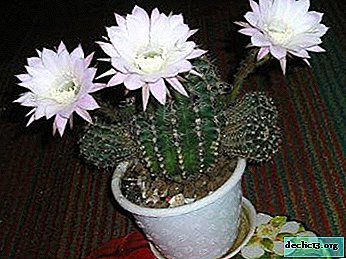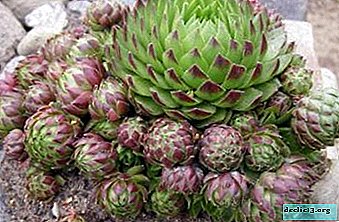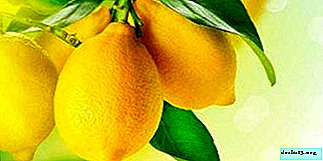A popular home cactus echinopsis - its main types with photos and rules for care

Echinopsis is a type of cactus that looks like a ball with thorns at an early age. And this is not surprising, since its name came from two words: "echino" - a hedgehog, "opsis" - similar.
As they grow older, the cactus stretches up. Some types of echinopsis can reach a height of 2 m.
Echinopsis is a home plant that has conquered flower growers with its diversity. In the article, we will consider in detail each type of echinopsis cactus.
Popular Echinopsis species with names and photos
Subdenudata

This species is distinguished by the absence of thorns. In a fluffy light areola, one or two small spines are concentrated. The shape of the cactus has the appearance of a flattened ball, on which there are 10-12 sharp ribs.
Eyrieza (Eyriesii)
 This type of cactus is able to give a lot of lateral "kids." The number of ribs is 11-18. Spikes of small sizes - 0.5 cm. The areoles in the upper part of the flower are noticeable, they have a white fluff. The flowers are wide and pale pink petals growing in several rows.
This type of cactus is able to give a lot of lateral "kids." The number of ribs is 11-18. Spikes of small sizes - 0.5 cm. The areoles in the upper part of the flower are noticeable, they have a white fluff. The flowers are wide and pale pink petals growing in several rows.
Gruzoni

This species has a spherical stem, which in mature plants becomes barrel-shaped. It grows up to 1 m in width and height. It does not scrub and does not form children. The flowers are single, yellow, 7 cm long, and 5 cm in diameter.
Pointed (Oxygona)

This species is distinguished by a thick stem resembling a ball. Its diameter is 20 cm, and in height it stretches as the plant grows. There are clearly defined ribs - 13-15. On them areoles with spines are located. In young specimens, the spines are yellow, slightly dark at the ends.
Pachanoi

This cactus has a columnar tree-shaped stem, the height of which is 5-6 m. Color - dark green. Adult specimens have 6-8 wide and rounded ribs. White flowers, their shape is tubular, and the length is 22-23 cm.
Peruviana

This cactus is a bluish-green color. Its stems are matte, and the ribs are rounded and wide. During flowering, the plant is covered with white flowers. The stem height reaches 3-6 m, and the diameter is 8-18 cm. Under natural conditions, the plant grows in small groups.
Leucantha

The stalk of a cactus is round or short cylindrical. Its color is gray-green. It has 12-14 ribs that are blunt and slightly tuberous. Areola yellow-white, oblong. The flowers are located at the crown of the stems, their length is 20 cm, and the color is white. Fruits are round, fleshy and dark red.
Eyriesii

This plant gives many lateral children, and ribs - 11-18 ribs. The thorns are small - 0.5 cm. The areoles are concentrated in the upper part of the cactus, they are very noticeable, have a white fluff. The flowers are pale pink, saturated. Even the flowers have wide petals growing in several rows.
Hybrid

Due to the wide variety of shapes and flowering of cacti, flower growers decided to cross several species to get a plant with an unusual color of flowers. Hybrid echinopsis differ:
- slow growth;
- almost complete absence of lateral shoots (children);
- abundant flowering;
- a variety of colors, terry and splendor of flowers.
Thanks to this, the following types began to appear:
- Golddollar;
- Madeira
- Bonzo
- Zanzibar;
- Sternaler.
Tubiflora

This cactus has a green stem, which is roundish in young plants. With age, the stalk becomes cylindrical. The number of ribs is 11-12, they are pronounced, equipped with deep grooves. Areoles are white or gray, spines are yellow with dark ends. The flowers are funnel-shaped, the color is white, and the length and diameter are 10 cm.
Hook-billed (Ancistrophora)

This is a miniature cactus, as its size in the transverse form is 8-10 cm. The shape of the stem is spherical, the crown is flat, covered with ribs in the amount of 20 pieces. On the ribs areola with spikes of light brown color. Large flowers - diameter 10 cm, and the tube - 15 cm.
Golden

This is the smallest type of echinopsis., since its height is 10 cm. At first, the shape of the stem resembles a ball, with age it grows upward, and the apex becomes flattened. The spines are brownish-golden; they focus on the edges of the cactus. The flowers are bright yellow, they have a diameter of 8 cm.
Huascha

This species is distinguished by curved dark green stems with a diameter of 5-8 cm and a height of 50-90 cm. The number of ribs is 12-18 cm, and the areoles are brown and branching at the base. The flowers are funnel-shaped, their length reaches 7-10 cm. They bloom only in the daytime, their color is rich yellow. Fruits are rounded, yellow-green, diameter is 3 cm.
Mamillosa

This cactus has a spherical stem.. It has ribs with tubercles. Small spines are obtained from them, the length of which is 1 cm. The flowers have wide petals growing in several layers. Their color is pink.
Care
Echinopsis is not picky in care, but there are a number of requirements that must be observed for active growth and lush flowering of a cactus:
- Lighting. Echinopsis need bright lighting. The plant can tolerate a certain amount of direct sunlight.
- Temperature. In the summer, you need to maintain a temperature of 22-27 degrees. In autumn, the temperature regime should be reduced by 2-3 degrees. In winter, a temperature of 6-12 degrees is required.
- Watering. In spring and summer, water the plant every 2-3 days. With the onset of winter with a cool content, the plant does not need to be watered or rarely done.
- Air humidity. For echinopsis, this parameter is not important, so that they quietly tolerate dry air in the room.
- Fertilizer. During the growth and flowering of a plant, fertilizing should be done once a month, using special fertilizers for cacti. In winter, echinopsis does not need to be fertilized.
- Transfer. Cacti need to be transplanted every 2-3 years. Do it early in the spring. Use is worth a ready-made substrate for cacti with pH6. Place drainage at the bottom of the pot, and after transplanting, do not water the plant for 6-8 days. This will prevent the root system from decaying.
All the details about caring for this beautiful plant can be found here.
Each of these species differs in size, color of flowers and features in care. For lovers of cacti, this is a great opportunity to create a mini-greenhouse from different types of echinopsis in your home.

















